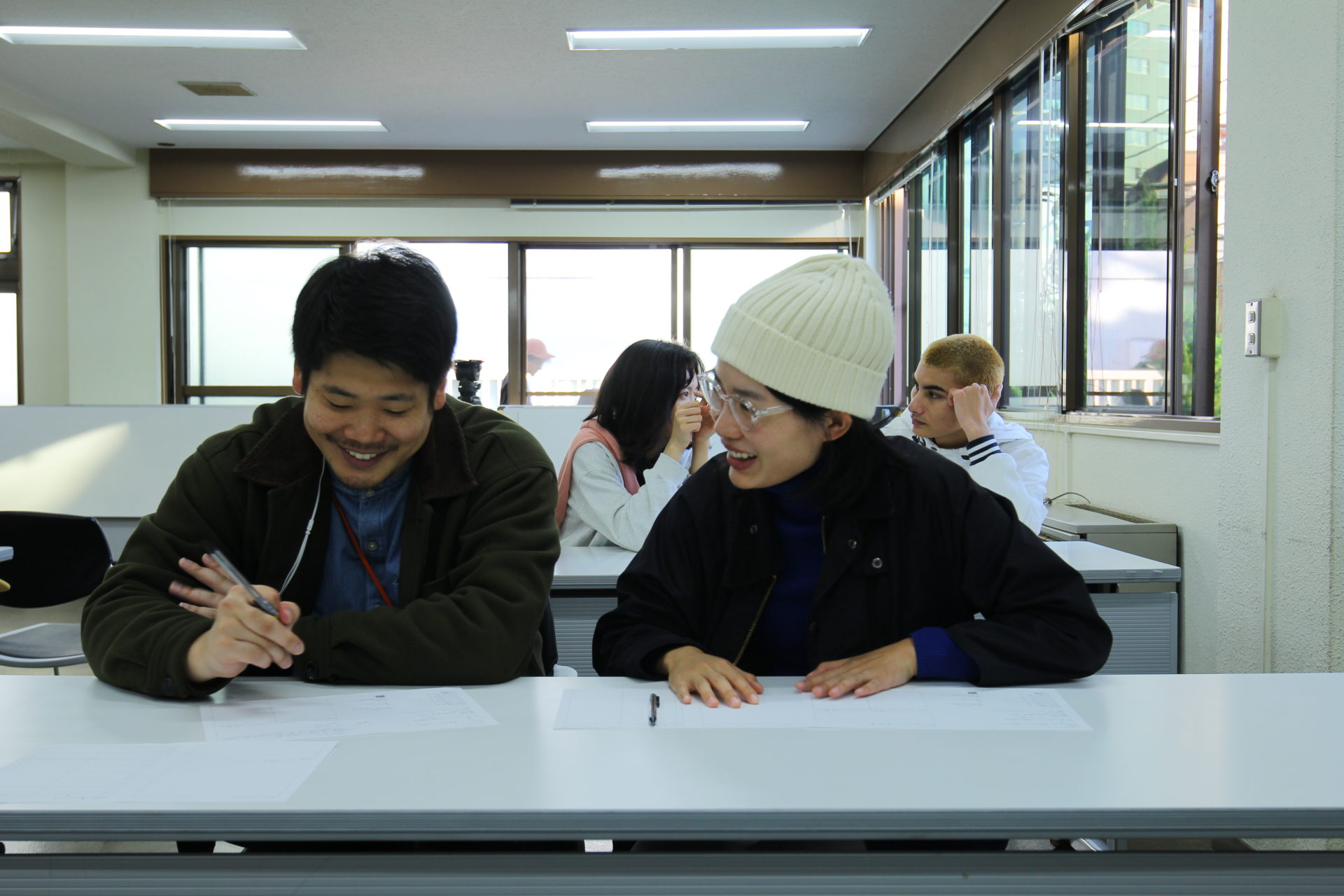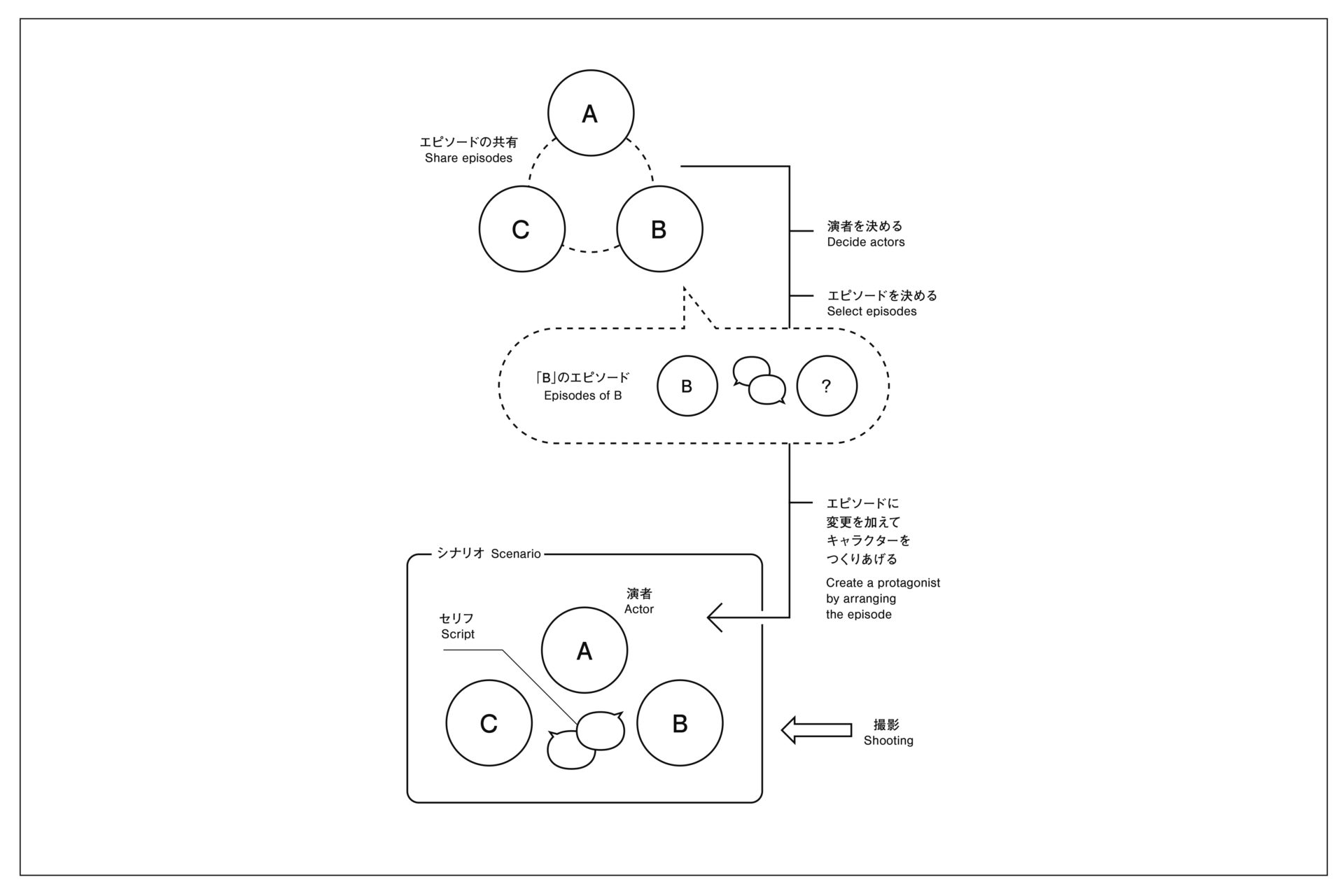
手法5:シネマエチュードMethod 5: Cinema Etude
シネマエチュードのルールThe rule of Cinema Etude
3人組のグループにより、参加者自身の経験をもとにした5分程度の短いフィクション作品をつくる。今年度は、共通のテーマを「再会」、設定を「数年ぶりに再会した2人/とある映画館での上映前の会話」とし、複数のグループによる作品群がひとつのオムニバス作品となることを目指した枠組みで実施された。また、撮影、編集はともにシンプルに行うためのルールが設けられ(カメラは固定/1カット)、“シナリオをつくる”ことと“演じる”ことをプログラムの焦点とした。その部分は以下のステップを踏む。
① グループ内で経験を共有する:テーマに合わせて、参加者それぞれの経験をグループ内で話し、聞き、作品の軸となるエピソードを選ぶ。
② キャラクターをつくる:選んだエピソードを演じる人を決め、演者の特徴と、ワークショップ内で決められた設定に合わせて、エピソードに変更を加えながら、作品に登場するキャラクターをつくりあげる。
③ シナリオをつくる:キャラクターに合わせて、プロットやセリフなどを決める。In groups of three, participants create a short fictional work, approximately five minutes long, based on their own experiences. This year, the theme “reunion” and the setting “two people reunite after several years / conversation before screening at a movie theater” was commonly set for multiple groups to produce their works which was aimed to eventualize into a single omnibus film. To keep both filming and editing process simple, two rules (keep camera fixed / take the film by a single cut) was implemented so as to keep program focus on “creating the scenario” and “acting out.” The following steps were taken to achieve this.
1: Share experiences within the group members: Participants shared and discussed each other’s experiences based on the given theme, and selected an episode that would become a core of the work.
2: Create the protagonist: The actor was selected among the group to act as the protagonist of the work, whose character was created based on the assigned setting and episode adaptation.
3: Create the scenario: Create the plot and scenario based on the protagonist.

シネマエチュードの作品The works of Cinema Etude
「シネマエチュード」は「KINOローグ」と同様に、「シネマポートレイト」の経験者を対象とした“ステップアップワークショップ”であり、KINOミーティングが初めて実施したフィクションを扱うプログラムである。複数人が参加するワークショップなどでフィクションを扱う際にハードルとなるのは、シナリオを誰がどのように書くか? という点である。特定のひとりがシナリオを書き、それにあわせて演者を配役していくのがセオリーではあるが、KINOミーティングが常に目指している協働の姿とはマッチしない。そこで「シネマエチュード」では、“演じる”ことから“シナリオをつくる”という手順を踏むことにより、演者たちが協働して自分たちのシナリオをつくるという方針をとった。
あるひとりの過去に起こった出来事を、グループのなかの3人で演じきることで、それがフィクション作品として立ち上がる。実際に起こったことを、3人で完全に再現することはきっと難しい。エピソードの登場人物と実際に演じる人物との間には、ルーツや扱う言語、性格や年齢まで、さまざまな違いがあるだろう。そこで、そのエピソードを3人なりに再現するために必要な変更を加えて“アジャスト”していく。そのプロセスを重ねることで、ひとつのオリジナルなシナリオができあがる。
また、このプロセスは、演者にとって“他者の存在を、自分という存在を通して演じる”経験となる。演者は、演じる対象者の言動の根幹にある経験に思いを馳せるだろうし、どの部分をアジャストすれば自分が演じることができるのかを考えることで、自分自身についてもあらためて目を向けることになるだろう。本人が演じる場合でも、過去の自分からいまの自分への変化を確認する作業になる。完成した作品では完全に可視化はされないが、自分を他者に/他者を自分にアジャストすることで、時や空間を超えたコミュニケーションが発生している。Like KINO-Logue, Cinema Etude is a “step-up workshop” for participants who have experienced the Cinema Portrait workshop, and the first fiction-based program held by KINO Meeting. When dealing with fiction in workshops with multiple participants, one of the difficulties we face is when we decide who should write the scenario and how. When following an orthodox theory, a specific person may write the scenario and cast the actors accordingly, but this does not match the collaborative attitude that KINO Meeting always strives for. Therefore, in Cinema Etude, we adopted the policy of having performers work together to create their original scenarios by acting first, then create the scenario.
When three members of a group act out an actual event that happened in one person’s past, it becomes a fiction. Surely it may be difficult for the three to completely recreate what happened in reality. There may be many differences between the protagonist and the actor, including their backgrounds, languages, personalities, and ages. Therefore, the three made necessary changes and “adjustments” to recreate the episode in their own way. An original scenario was created by repeating this process.
Moreover, the process provides the actor with the experience of “acting out others through themselves.” The actors may think about the experiences behind the protagonist’s words and actions, or reconsider their own selves by thinking about what points they need to arrange to be able to perform better. Even when the original figure of the protagonist is acting their own self, it is a process of confirming the change from their past to the present. Although it is not fully obvious in the completed work, an interaction transcending time and place occurs by adjusting oneself to others or others to oneself.
シネマエチュード『再見』
シネマエチュードBehind The Scenes

